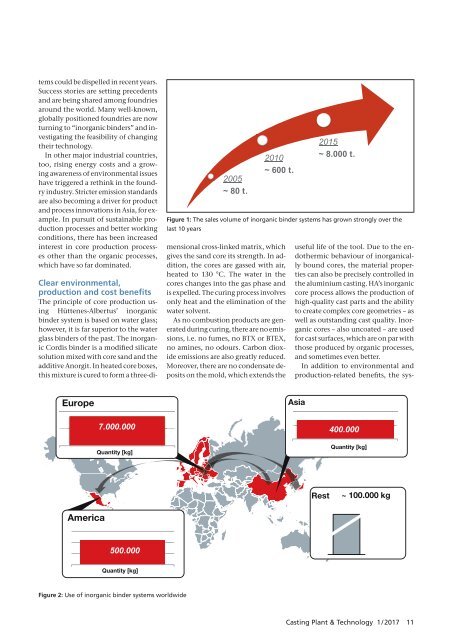CPT International 01/2017
The leading technical journal for the global foundry industry – Das führende Fachmagazin für die weltweite Gießerei-Industrie
The leading technical journal for the
global foundry industry – Das führende Fachmagazin für die
weltweite Gießerei-Industrie
You also want an ePaper? Increase the reach of your titles
YUMPU automatically turns print PDFs into web optimized ePapers that Google loves.
tems could be dispelled in recent years.<br />
Success stories are setting precedents<br />
and are being shared among foundries<br />
around the world. Many well-known,<br />
globally positioned foundries are now<br />
turning to “inorganic binders” and investigating<br />
the feasibility of changing<br />
their technology.<br />
In other major industrial countries,<br />
too, rising energy costs and a growing<br />
awareness of environmental issues<br />
have triggered a rethink in the foundry<br />
industry. Stricter emission standards<br />
are also becoming a driver for product<br />
and process innovations in Asia, for example.<br />
In pursuit of sustainable production<br />
processes and better working<br />
conditions, there has been increased<br />
interest in core production processes<br />
other than the organic processes,<br />
which have so far dominated.<br />
The sales volume of inorganic binder systems has grown strongly over the<br />
last 10 years<br />
Clear environmental,<br />
<br />
The principle of core production using<br />
Hüttenes-Albertus’ inorganic<br />
binder system is based on water glass;<br />
however, it is far superior to the water<br />
glass binders of the past. The inorganic<br />
Cordis binder is a modified silicate<br />
solution mixed with core sand and the<br />
additive Anorgit. In heated core boxes,<br />
this mixture is cured to form a three-dimensional<br />
cross-linked matrix, which<br />
gives the sand core its strength. In addition,<br />
the cores are gassed with air,<br />
heated to 130 °C. The water in the<br />
cores changes into the gas phase and<br />
is expelled. The curing process involves<br />
only heat and the elimination of the<br />
water solvent.<br />
As no combustion products are generated<br />
during curing, there are no emissions,<br />
i.e. no fumes, no BTX or BTEX,<br />
no amines, no odours. Carbon dioxide<br />
emissions are also greatly reduced.<br />
Moreover, there are no condensate deposits<br />
on the mold, which extends the<br />
useful life of the tool. Due to the endothermic<br />
behaviour of inorganically<br />
bound cores, the material properties<br />
can also be precisely controlled in<br />
the aluminium casting. HA’s inorganic<br />
core process allows the production of<br />
high-quality cast parts and the ability<br />
to create complex core geometries – as<br />
well as outstanding cast quality. Inorganic<br />
cores – also uncoated – are used<br />
for cast surfaces, which are on par with<br />
those produced by organic processes,<br />
and sometimes even better.<br />
In addition to environmental and<br />
production-related benefits, the sys-<br />
Europe<br />
Asia<br />
7.000.000<br />
400.000<br />
Quantity [kg]<br />
Quantity [kg]<br />
Rest<br />
~ 100.000 kg<br />
America<br />
500.000<br />
Quantity [kg]<br />
Figure 2: Use of inorganic binder systems worldwide<br />
Casting Plant & Technology 1 / 2<strong>01</strong>7 11


















